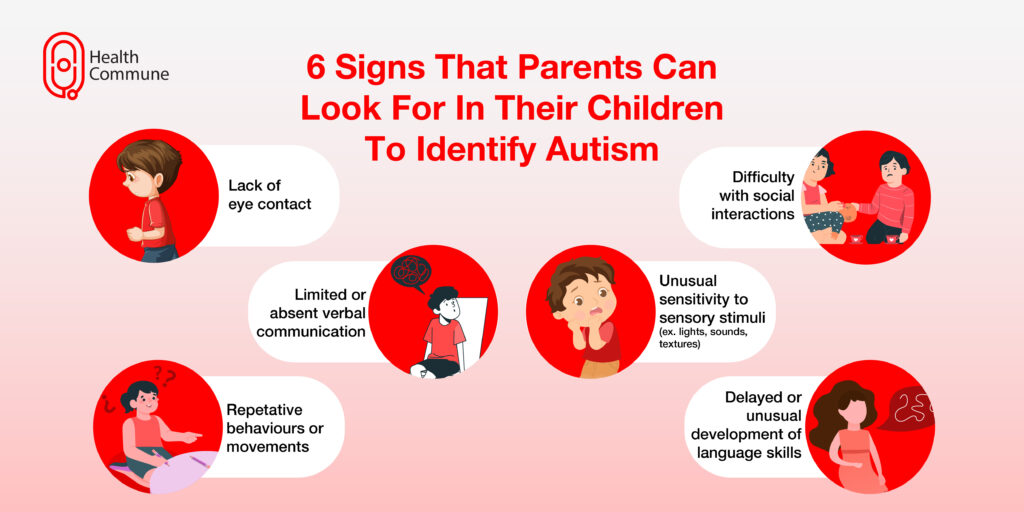What do you mean by autism?
What are the types of autism?
The five different subtypes of autism include:
- Autism with or without accompanying intellectual impairment
- Autism with or without accompanying language impairment
- Autism associated with a known medical or genetic condition or environmental factors
- Autism associated with another neurodevelopmental, mental, or behavioural disorder
- Autism with catatonia (a condition that impairs a person’s awareness of their surroundings)
What causes autism?
- having a member from one’s immediate family with autism or having particular genetic variants
- hereditary diseases such as fragile X syndrome (a genetic disorder that results in a variety of developmental issues, such as cognitive impairment and learning impairments)
- late pregnancy
- low birth weight
- metabolic imbalances
- exposure to heavy metals and environmental toxins
- maternal history of viral infections
- fetal exposure to certain medications like valproic acid or thalidomide
What are some symptoms of autism?
A.Social Communication and Interaction Skills
For those with autism, social interaction and communication skills might be difficult. Your child may be:
- Avoiding eye contact
- Not responding to their name by the age of nine months
- Not displaying joyful, sad, angry, or astonished facial expressions by the age of nine months
- Not engaging in simple interactive games like by 12 months
- By the age of one year, making only a few or no gestures (for example, does not wave goodbye)
- By the age of 15 months, not sharing their interests with others (for example, shows you an object that they like)
- By the age of 18 months, not pointing to show you something new
- At the age of 24 months, not recognising when others are harmed or unhappy
- By the age of 36 months, not observing or engaging in play with other children
- At the age of 48 months, not pretending to be someone else during play, such as a teacher or a superhero
- Not performing, singing, dancing, or acting by the age of 60 months
B. Restricted/Repetitive Behaviors or Interests
Examples of restricted or repetitive behaviours in your child are:
- Setting toys or other items in a line and becoming upset if the order is changed
- Using the same set of words or phrases again and again (‘echolalia’)
- Using the same order of play with toys each time
- Concentrating on object components (for example, wheels)
- Getting upset by even little changes
- Fixating on very specific obsessions
Other symptoms include:
- Delayed language abilities
- Delayed abilities in learning or thinking
- Inattentive, impulsive, or hyperactive behaviour
- A seizure or epilepsy disorder(sudden uncontrolled movements in the brain which causes changes in behaviour, movements and feelings)
- Unusual patterns of eating and sleeping
- Digestive disorders (for example, constipation)
- Unusual emotional or mood swings
- Excessive concern, tension, or anxiety

How is autism diagnosed?
- The Modified Checklist for Autism in Toddlers (M-CHAT): is a standard screening tool in which parents answer 23 questions about their child. Following that, paediatricians can use the responses to identify kids who could be more likely to experience ASD. It’s important to remember that children that test positive may not actually have the disorder and not all autistic children can be detected through this test
- Occupational therapy screening: is done to understand the individual’s expertise, skills, and disabilities
- Behavioural evaluation: involves a methodical examination of the child’s functional issues, which is utilised to develop a structured behavioural plan aimed at enhancing their adaptive abilities and reducing inappropriate conduct
- DNA testing: for genetic diseases
- Vision and audio testing: to rule out any abnormalities that aren’t related to ASD

What is the treatment plan for autism?
The aim of treatment is to improve your child’s functioning by minimising their symptoms and promoting growth and learning. Important social, communicative, functional, and behavioural skills can be learned by your kid through early intervention during the preschool years. This includes:
Educational therapies: Educational programmes with a strict structure frequently work effectively for kids with an autism spectrum disorder. A team of specialists and a range of activities are often used in effective programmes to enhance social skills, communication, and behaviour
Family therapy: In this, parents and other family members can learn how to play and engage with their kids in ways that encourage social skills, control problem behaviours, and impart communication and everyday life skills
Behaviour and communication therapies: These programmes concentrate on eliminating problematic habits and providing exposure to new knowledge. Other initiatives concentrate on instructing kids on how to behave in social situations or improve their interpersonal communication. Through a reward-based motivation system, applied behaviour analysis (ABA) can assist youngsters in learning new skills and generalising these skills to a variety of settings
Occupational therapy: This teaches daily living skills, physical therapy, which improves movement and balance, and speech therapy, depending on your child’s needs
Medications: This is used if your child exhibits excessive activity. Severe behavioural issues may be treated with antipsychotic medications while anxiety can be treated with antidepressants
How can I prevent autism?
There is no prevention for autism. There are certain steps that would help parents to manage their children with autism:
- Become as knowledgeable as you can about autism spectrum disorder
- Establish a regular framework and schedule
- Connect with other parents of autistic children
- For specific issues, seek professional assistance
- Give yourself and your family some time to cope with the condition





